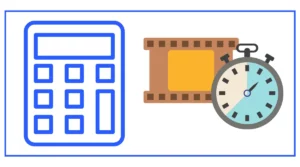Resonant Circuit Bandwidth Calculator
To calculate the bandwidth of a circuit, enter its resonant frequency and quality factor into the calculator.
This will calculate the bandwidth and show it in hz. You might want to find out the timecodes or frames to timecodes.
BW=fc/Q
- BW = bandwidth (Hz)
- fc = resonant frequency (Hz)
- Q = quality factor

Introduction to RLC Circuits
An RLC circuit is a fundamental component in electrical engineering and electronics. It consists of three key elements: a resistor (R), an inductor (L), and a capacitor (C). These circuits are widely used in various applications, including radio transmitters, filters, and oscillators. Understanding how to calculate the resonant frequency and bandwidth of an RLC circuit is crucial for engineers and technicians working with electronic systems.
What is an RLC Circuit?
An RLC circuit combines resistance, inductance, and capacitance in a single circuit. These components can be arranged in series or parallel configurations, each with its own characteristics and applications. The behavior of an RLC circuit is determined by the values of its components and how they interact with each other.
Series RLC Circuit
In a series RLC circuit, the resistor, inductor, and capacitor are connected in a single path. The current flowing through each component is the same, but the voltage across each element may differ.
Parallel RLC Circuit
In a parallel RLC circuit, the resistor, inductor, and capacitor are connected across the same two points. The voltage across each component is the same, but the current through each element may differ.
Resonant Frequency in RLC Circuits
The resonant frequency, also known as the natural frequency, is a critical parameter in RLC circuits. It is the frequency at which the inductive reactance and capacitive reactance are equal in magnitude but opposite in phase, resulting in maximum energy transfer between the inductor and capacitor.
Formula for Resonant Frequency
The resonant frequency (f₀) of an RLC circuit is calculated using the following formula:
f₀ = 1 / (2π √(LC))
Where:
- L is the inductance in henries (H)
- C is the capacitance in farads (F)
RLC Circuit Calculator: Calculating Resonant Frequency
Our RLC circuit calculator is a useful tool for determining the resonant frequency of both series and parallel RLC circuits. To use the calculator, follow these steps:
- Enter the value of inductance (L) in henries.
- Enter the value of capacitance (C) in farads.
- Click the “Calculate” button.
The calculator will then compute and display the resonant frequency in hertz (Hz).
Bandwidth in RLC Circuits
Bandwidth is another important characteristic of RLC circuits, particularly in filter and communication applications. It represents the range of frequencies over which the circuit effectively operates or responds.
Calculating Bandwidth
The bandwidth (BW) of an RLC circuit is related to its resonant frequency (f₀) and quality factor (Q) as follows:
BW = f₀ / Q
Where:
- f₀ is the resonant frequency in hertz (Hz)
- Q is the quality factor (dimensionless)
Quality Factor in RLC Circuits
The quality factor, often denoted as Q, is a measure of the energy-storing efficiency of an RLC circuit. It is defined as the ratio of energy stored to energy dissipated per cycle at resonance.
Formula for Quality Factor
For a series RLC circuit, the quality factor is calculated using:
Q = (1/R) √(L/C)
For a parallel RLC circuit, the formula is:
Q = R √(C/L)
Where:
- R is the resistance in ohms (Ω)
- L is the inductance in henries (H)
- C is the capacitance in farads (F)
Applications of RLC Circuits
RLC circuits have numerous applications in electronics and electrical engineering:
- Radio receivers and transmitters
- Filters for signal processing
- Oscillators in electronic circuits
- Power supplies for smoothing voltage fluctuations
- Tuning circuits in radio and television
- Impedance matching networks
Practical Examples Using the RLC Circuit Calculator
Let’s explore some practical examples to demonstrate the use of our RLC circuit calculator.
Example 1: Radio Tuning Circuit
Suppose you’re designing a radio tuning circuit and need to determine the resonant frequency for a specific station. You have an inductor with 100 μH inductance and a variable capacitor that can be adjusted between 10 pF and 100 pF.
Using the calculator:
- Enter L = 100 μH (0.0001 H)
- Enter C = 50 pF (5 × 10^-11 F) as a starting point
- Calculate the resonant frequency
The calculator will show a resonant frequency of approximately 2.25 MHz. You can then adjust the capacitance value to fine-tune the circuit to the desired radio frequency.
Example 2: Bandpass Filter Design
In designing a bandpass filter for an audio application, you need to determine the bandwidth. You have a circuit with a resonant frequency of 1 kHz and a quality factor of 10.
Using the bandwidth formula:
BW = f₀ / Q
BW = 1000 Hz / 10
BW = 100 Hz
This means the filter will effectively pass frequencies between 950 Hz and 1050 Hz.
Importance of RLC Circuit Calculations in Electronics
Understanding and being able to calculate RLC circuit parameters is crucial for several reasons:
- Circuit design: Proper calculation ensures that circuits operate at the intended frequencies and bandwidths.
- Signal processing: RLC circuits are fundamental in designing filters for various signal processing applications.
- Power efficiency: In power systems, RLC calculations help optimize energy transfer and minimize losses.
- Troubleshooting: When diagnosing issues in electronic systems, knowing how to calculate and interpret RLC circuit values is invaluable.
- Component selection: Accurate calculations allow engineers to choose the right components for specific applications.
Tips for Using the RLC Circuit Calculator
To get the most out of the RLC circuit calculator, keep these tips in mind:
- Use consistent units: Ensure that you’re using consistent units for inductance (henries) and capacitance (farads).
- Consider parasitic effects: In real-world applications, components may have parasitic inductance or capacitance that can affect calculations.
- Verify results: Always double-check your calculations using manual methods or alternative tools to ensure accuracy.
- Understand limitations: Remember that the calculator provides ideal results and may not account for all real-world factors.
- Experiment with values: Use the calculator to explore how changing component values affects the circuit’s behavior.





